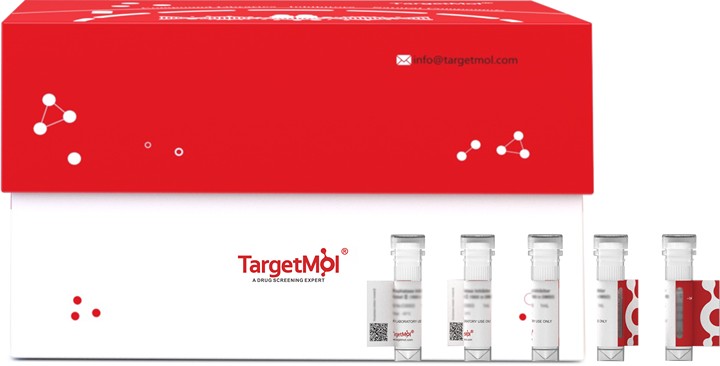- 全部删除
 您的购物车当前为空
您的购物车当前为空
POLQ Protein, Human, Recombinant (His)
DNA polymerase that promotes microhomology-mediated end-joining (MMEJ), an alternative non-homologous end-joining (NHEJ) machinery triggered in response to double-strand breaks in DNA. MMEJ is an error-prone repair pathway that produces deletions of sequences from the strand being repaired and promotes genomic rearrangements, such as telomere fusions, some of them leading to cellular transformation. POLQ acts as an inhibitor of homology-recombination repair (HR) pathway by limiting RAD51 accumulation at resected ends. POLQ-mediated MMEJ may be required to promote the survival of cells with a compromised HR repair pathway, thereby preventing genomic havoc by resolving unrepaired lesions. The polymerase acts by binding directly the 2 ends of resected double-strand breaks, allowing microhomologous sequences in the overhangs to form base pairs. It then extends each strand from the base-paired region using the opposing overhang as a template. Requires partially resected DNA containing 2 to 6 base pairs of microhomology to perform MMEJ. The polymerase activity is highly promiscuous: unlike most polymerases, promotes extension of ssDNA and partial ssDNA (pssDNA) substrates. Also exhibits low-fidelity DNA synthesis, translesion synthesis and lyase activity, and it is implicated in interstrand-cross-link repair, base excision repair and DNA end-joining. Involved in somatic hypermutation of immunoglobulin genes, a process that requires the activity of DNA polymerases to ultimately introduce mutations at both A/T and C/G base pairs.

POLQ Protein, Human, Recombinant (His)
| 规格 | 价格 | 库存 | 数量 |
|---|---|---|---|
| 20 μg | ¥ 3,120 | 20日内发货 | |
| 100 μg | ¥ 9,630 | 20日内发货 | |
| 500 μg | ¥ 13,700 | 20日内发货 |
产品信息
| 生物活性 | Activity has not been tested. It is theoretically active, but we cannot guarantee it. If you require protein activity, we recommend choosing the eukaryotic expression version first. |
| 产品描述 | DNA polymerase that promotes microhomology-mediated end-joining (MMEJ), an alternative non-homologous end-joining (NHEJ) machinery triggered in response to double-strand breaks in DNA. MMEJ is an error-prone repair pathway that produces deletions of sequences from the strand being repaired and promotes genomic rearrangements, such as telomere fusions, some of them leading to cellular transformation. POLQ acts as an inhibitor of homology-recombination repair (HR) pathway by limiting RAD51 accumulation at resected ends. POLQ-mediated MMEJ may be required to promote the survival of cells with a compromised HR repair pathway, thereby preventing genomic havoc by resolving unrepaired lesions. The polymerase acts by binding directly the 2 ends of resected double-strand breaks, allowing microhomologous sequences in the overhangs to form base pairs. It then extends each strand from the base-paired region using the opposing overhang as a template. Requires partially resected DNA containing 2 to 6 base pairs of microhomology to perform MMEJ. The polymerase activity is highly promiscuous: unlike most polymerases, promotes extension of ssDNA and partial ssDNA (pssDNA) substrates. Also exhibits low-fidelity DNA synthesis, translesion synthesis and lyase activity, and it is implicated in interstrand-cross-link repair, base excision repair and DNA end-joining. Involved in somatic hypermutation of immunoglobulin genes, a process that requires the activity of DNA polymerases to ultimately introduce mutations at both A/T and C/G base pairs. |
| 种属 | Human |
| 表达系统 | Baculovirus Insect Cells |
| 标签 | C-6xHis |
| 蛋白编号 | O75417 |
| 氨基酸序列 | GFKDNSPISDTSFSLQLSQDGLQLTPASSSSESLSIIDVASDQNLFQTFIKEWRCKKRFSISLACEKIRSLTSSKTATIGSRFKQASSPQEIPIRDDGFPIKGCDDTLVVGLAVCWGGRDAYYFSLQKEQKHSEISASLVPPSLDPSLTLKDRMWYLQSCLRKESDKECSVVIYDFIQSYKILLLSCGISLEQSYEDPKVACWLLDPDSQEPTLHSIVTSFLPHELPLLEGMETSQGIQSLGLNAGSEHSGRYRASVESILIFNSMNQLNSLLQKENLQDVFRKVEMPSQYCLALLELNGIGFSTAECESQKHIMQAKLDAIETQAYQLAGHSFSFTSSDDIAEVLFLELKLPPNREMKNQGSKKTLGSTRRGIDNGRKLRLGRQFSTSKDVLNKLKALHPLPGLILEWRRITNAITKVVFPLQREKCLNPFLGMERIYPVSQSHTATGRITFTEPNIQNVPRDFEIKMPTLVGESPPSQAVGKGLLPMGRGKYKKGFSVNPRCQAQMEERAADRGMPFSISMRHAFVPFPGGSILAADYSQLELRILAHLSHDRRLIQVLNTGADVFRSIAAEWKMIEPESVGDDLRQQAKQICYGIIYGMGAKSLGEQMGIKENDAACYIDSFKSRYTGINQFMTETVKNCKRDGFVQTILGRRRYLPGIKDNNPYRKAHAERQAINTIVQGSAADIVKIATVNIQKQLETFHSTFKSHGHREGMLQSDQTGLSRKRKLQGMFCPIRGGFFILQLHDELLYEVAEEDVVQVAQIVKNEMESAVKLSVKLKVKVKIGASWGELKDFDV |
| 蛋白构建 | 1792-2590 aa |
| 蛋白纯度 | > 85% as determined by SDS-PAGE. |
| 分子量 | 92.3 kDa (predicted) |
| 内毒素 | < 1.0 EU/μg of the protein as determined by the LAL method. |
| 缓冲液 | If the delivery form is liquid, the default storage buffer is Tris/PBS-based buffer, 5%-50% glycerol. If the delivery form is lyophilized powder, the buffer before lyophilization is Tris/PBS-based buffer, 6% Trehalose, pH 8.0. |
| 复溶方法 | Reconstitute the lyophilized protein in sterile deionized water. The product concentration should not be less than 100 μg/mL. Before opening, centrifuge the tube to collect powder at the bottom. After adding the reconstitution buffer, avoid vortexing or pipetting for mixing. |
| 存储 | Lyophilized powders can be stably stored for over 12 months, while liquid products can be stored for 6-12 months at -80°C. For reconstituted protein solutions, the solution can be stored at -20°C to -80°C for at least 3 months. Please avoid multiple freeze-thaw cycles and store products in aliquots. |
| 运输方式 | In general, Lyophilized powders are shipping with blue ice. Solutions are shipping with dry ice. |
| 研究背景 | DNA polymerase that promotes microhomology-mediated end-joining (MMEJ), an alternative non-homologous end-joining (NHEJ) machinery triggered in response to double-strand breaks in DNA. MMEJ is an error-prone repair pathway that produces deletions of sequences from the strand being repaired and promotes genomic rearrangements, such as telomere fusions, some of them leading to cellular transformation. POLQ acts as an inhibitor of homology-recombination repair (HR) pathway by limiting RAD51 accumulation at resected ends. POLQ-mediated MMEJ may be required to promote the survival of cells with a compromised HR repair pathway, thereby preventing genomic havoc by resolving unrepaired lesions. The polymerase acts by binding directly the 2 ends of resected double-strand breaks, allowing microhomologous sequences in the overhangs to form base pairs. It then extends each strand from the base-paired region using the opposing overhang as a template. Requires partially resected DNA containing 2 to 6 base pairs of microhomology to perform MMEJ. The polymerase activity is highly promiscuous: unlike most polymerases, promotes extension of ssDNA and partial ssDNA (pssDNA) substrates. Also exhibits low-fidelity DNA synthesis, translesion synthesis and lyase activity, and it is implicated in interstrand-cross-link repair, base excision repair and DNA end-joining. Involved in somatic hypermutation of immunoglobulin genes, a process that requires the activity of DNA polymerases to ultimately introduce mutations at both A/T and C/G base pairs. |




